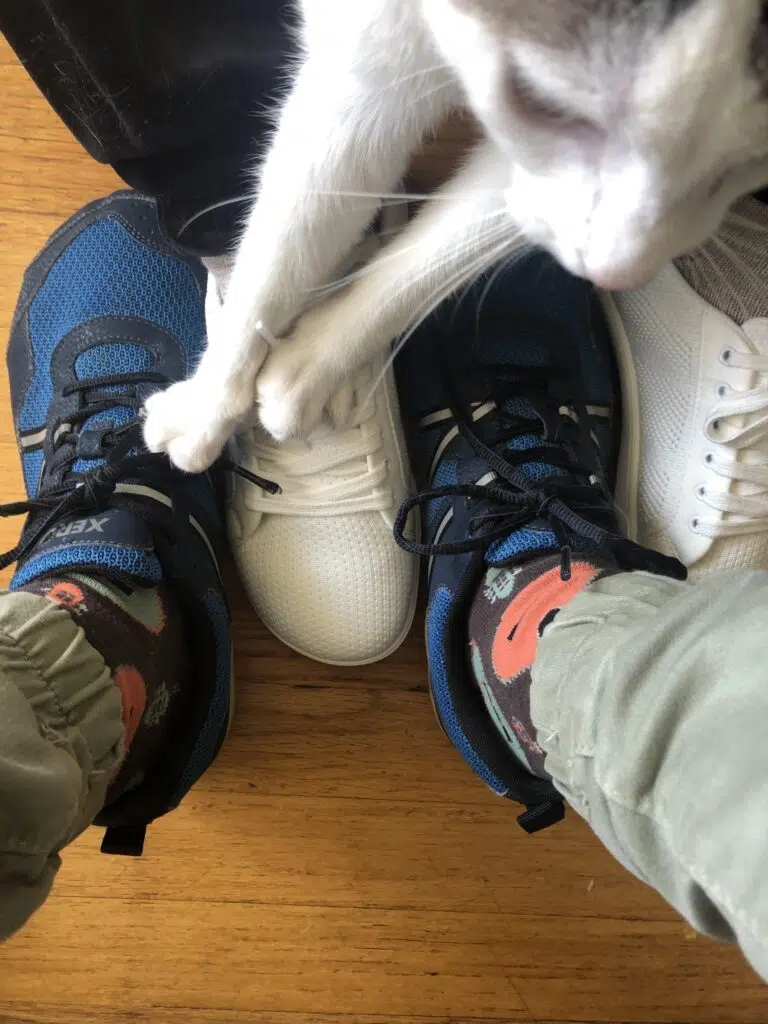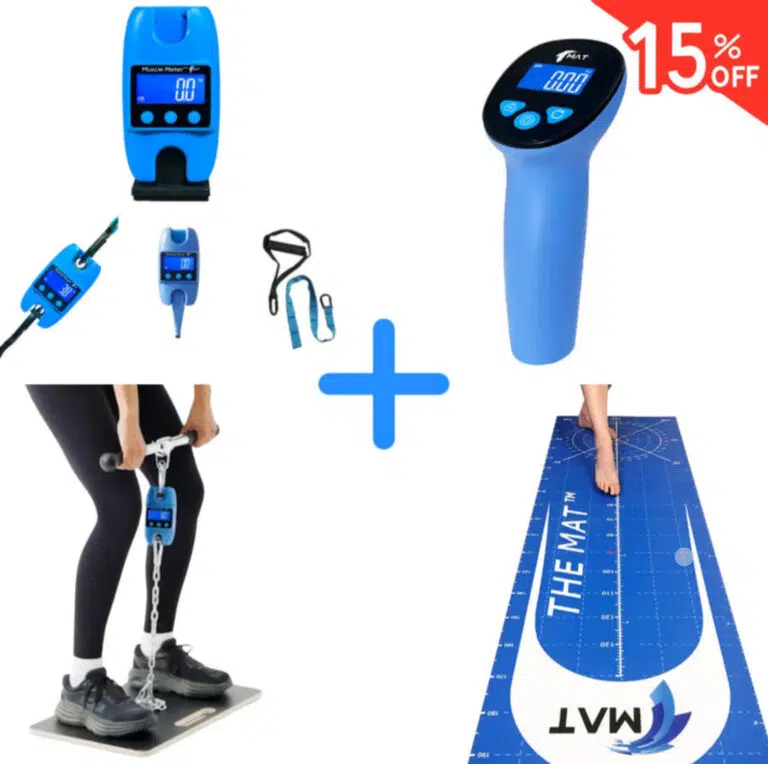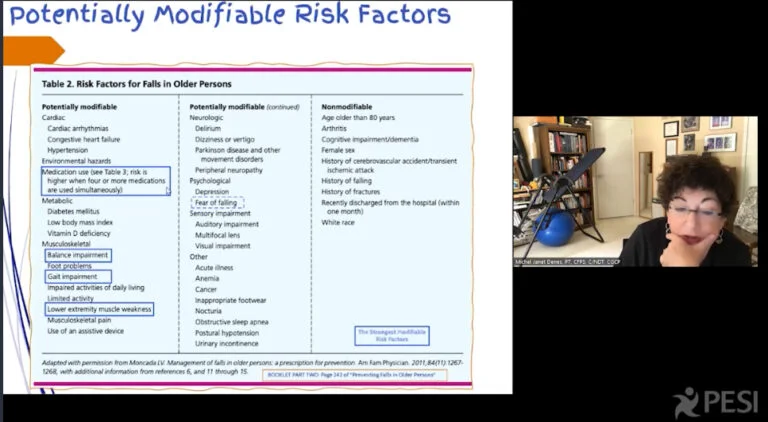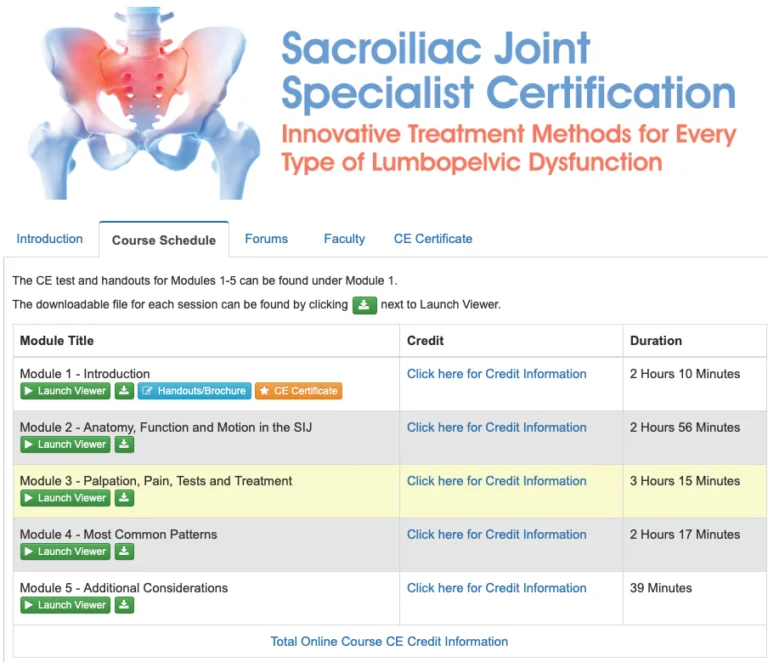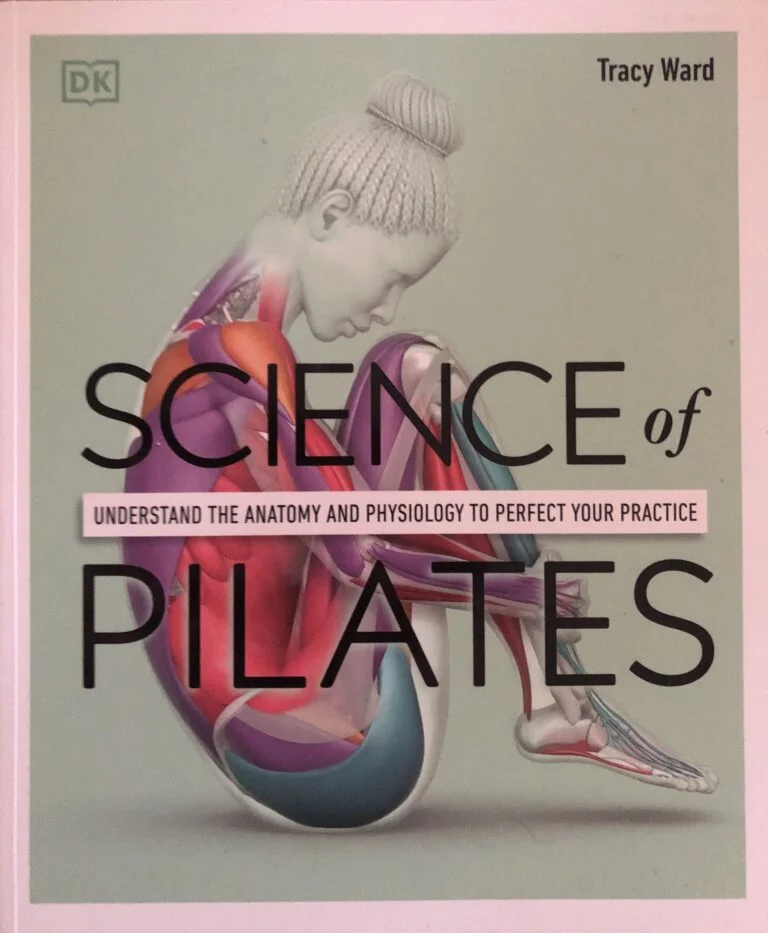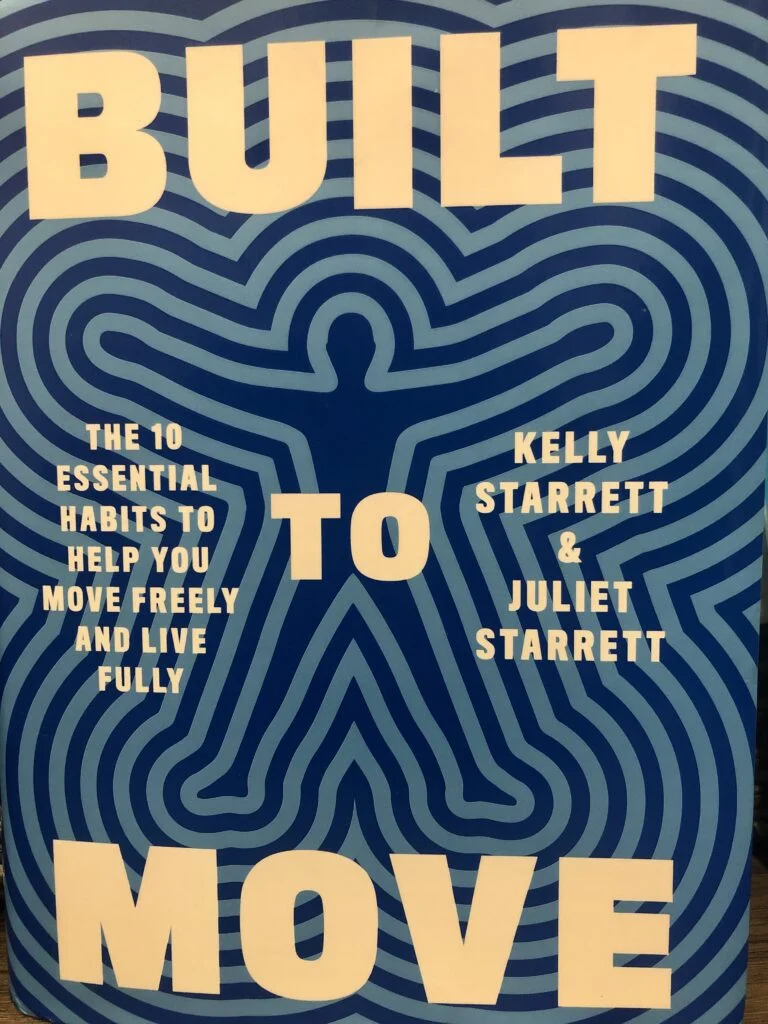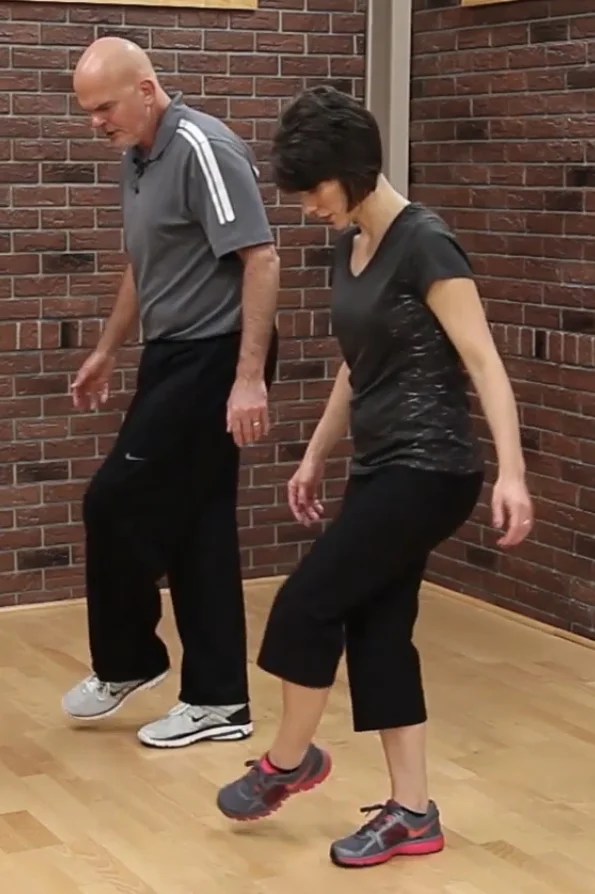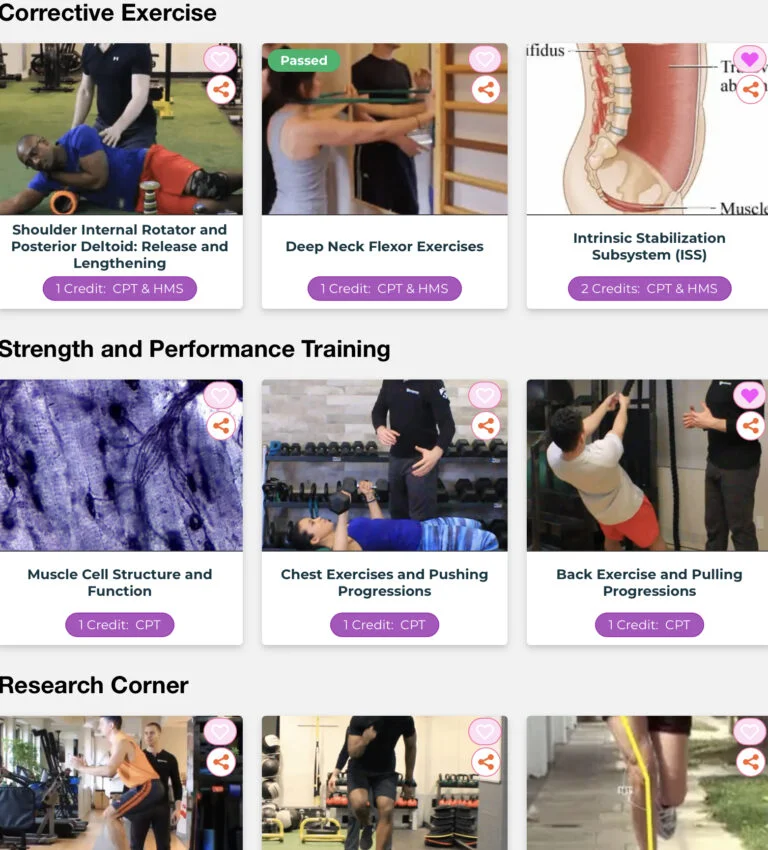An excellent fall prevention course can be a life saver. Now you’re able to learn the latest advice, exercises, and recommended practices from a leading expert in fall prevention. Putting just a few tips into action can help you or your clients avoid tumbles that can have serious consequences.
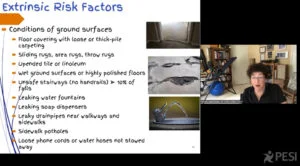
Here, you’ll find a full review of the Fall Prevention Specialist Certification, offered through PESI. In brief, this fall prevention course is not only a great value; it’s of unlimited value! The course is:
- Well-organized
- Practical: with many easy-to-implement tips for safety around the home and exercises
- Up to date with the latest research
- Affordable, especially if you use our exclusive discount
A great thing about this course is that it has excellent information for a number of viewers:
- Seniors and those concerned with falling: connections to a number of fall-prevention resources (see below)
- Movement instructors: in addition to the above, also exercises and very practical advice for your clients
- Medical professionals
So, while medical professionals can receive continuing education credit for this fall prevention course, most of the material is very relevant to everyone.
This article also contains links to some resources and items that can help you protect yourself and your loved ones.
Click here to claim our exclusive discount to the Fall Prevention Specialist Certification Course.
Brandon’s Personal Note
As a Pilates instructor and bodyworker who deals with seniors all day, the Fall Prevention Course has deeply impacted how I plan my sessions. By implementing the instruction contained in the course, I’ve seen big improvements in clients’ balance and mobility within just a few sessions. Most of the exercises taught here can be given as homework as well, which helps maintain the gains.
I’ve also had some important talks with clients about fall preventing their homes and shared some printed material. Most home falls are easily preventable, and this course teaches you how to eliminate the most common causes of falls.
While we only review courses that we recommend, the Fall Prevention Certification is highly recommended because of the immediately relevant tips and valuable resources that are relevant to non-medical and medical professionals.
Who should take the Fall Prevention Specialist Certification Course?
First of all, this course isn’t only for those who want to practice as fall prevention specialists. The Fall Prevention Specialist Course is great for anyone who has concerns of falling or that someone they care for might fall. This is because the course is loaded with tips and resources for fall prevention.
We’ve divided how the course might be relevant for different populations below.
For those concerned with falling
- Files for brochures to accident-proof your home
- Lists of exercises to decrease your chances of falling
- Information about medications that can effect balance
For Movement Instructors (Pilates, yoga, personal trainers, etc.)
If you work with seniors (or anyone at risk for falling), then fall prevention should be a part of your programming. The Fall Prevention Specialist Certification is ideal for movement instructors of all kinds, because it teaches life-saving tips you can share while remaining within your scope of practice.
Some things you’ll find incredibly useful include:
- Quick questionnaires you can use to see if your client is at risk for falling
- Resources for helping you communicate with medical professionals about your client
- PDFs of checklists and brochures you can keep in your studio to inform your clients and help keep them safe
For Medical Professionals & Clinicians
At its core, the Fall Prevention Specialist Certification Course is intended for learners who, like the instructor, are physical or occupational therapists (or in similar clinical settings). Some of the course material makes use of a more medical approach to the body and addresses concerns of those in a medical setting. This includes:
- Advice on liaising with GPs and specialists to advise them regarding medication and your patient’s likelihood to fall
- Advice on how reports of danger of falling should be reported to be sure testing and treatment occur
- Resources to relevant secondary literature
- Discussion of leading tools and technology
- CECs available for PTs, PTAs, OT, and others
Fall Prevention Course Organization
The Fall Prevention Specialist Certification course includes the core material, “Fall Prevention,” as well as two additional bonus videos. All programs are taught by respected experts in the field who have both research and clinical experience.
- Fall Prevention. Instructor: Shelly Denes, PT, CFPS, C/NDT, CGCP.
- Module 1: Assessing Fall Risk & Neuroplasticity Techniques. Length: 5 hours
- Module 2: Gait Cycle, Shoes, Orthotics & Perturbation. Length: 4 hours
- Module 3: Preventing Falls, Case Studies and Special Populations 3.5 hours
2. Improving Functional Mobility & Gait Patterns Following Injury, Surgery & Aging. Instructor: Trent Brown, MOT, OTR/L, BCG, ATP, CFPS. 2 hours.
3. Empower Clients with Mobility Impairments: Using Technology to Improve Quality of Life. Instructor: Hillary Price, DPT, ATP. Length: 1 hour 22 minutes
Fall Prevention Course Instructors
This fall prevention course is really a 3 in 1, with three different topics address by experts in the field.
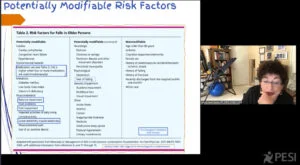
- Fall prevention: Shelly Denes, PT, CFPS, C/NDT, CGCP
- Improving Functional Mobility & Gait Patterns Following Injury, Surgery & Aging: Trent Brown, MOT, OTR/L, BCG, ATP, CFPS
- Empower Clients with Mobility Impairments: Using Technology to Improve Quality of Life: Hillary Price, DPT, ATP
Things You’ll Learn…
This fall prevention course is full of interesting, practical information. For example:
- Why walking with bifocals can put you at risk
- The importance of Vitamin D supplementation for many populations
- How improved sleep hygiene decreases fall risk
- Which test is most effective for predicting fall risk
- Methods for improving proprioception
Preventing the Deadly Trio
The most dangerous situation for a serious at home fall is where you wake up from a deep sleep and urgently need to go to the bathroom. Add to this situation inadequate lighting, and it the most common scenario for a serious fall.
- Sleeping pill: making you groggy when you get up
- Diuretic medication: causes more frequent urination
- Insufficient light
If you’re at risk of falling, it’s important to ask your GP to consider whether your medications might place you at risk. The Fall Prevention certification shares information about which combination of medication might make someone especially prone to fall at night.
Tip: Motion-detecting Nightlights
A golden piece of advice of Fall Prevention is to place a motion detecting nightlight. Place one of these next to the bed, so that as soon as your feet reach for the ground, the light turns on immediately.
You should have motion-detecting lights all the way to your path to the bathroom. You might also just leave a low light on in the bathroom.
If leaving a night light on all night disrupts your sleep, motion-detecting night lights are a good solution (they turn off after a few seconds). You might also consider a sleeping mask.
These are available as a 4-pack, which I’d recommend. You can set them along your path on the way to the bathroom.
Some recommendations for fall prevention:
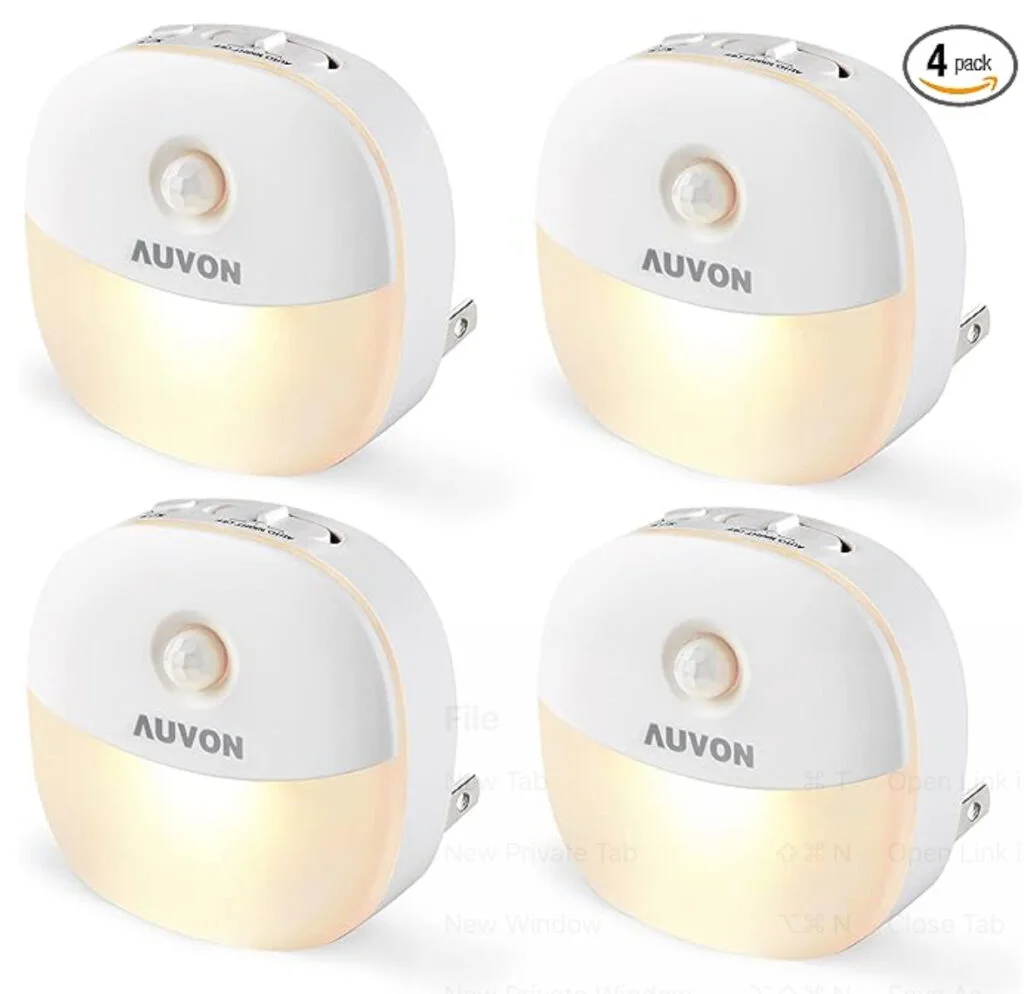

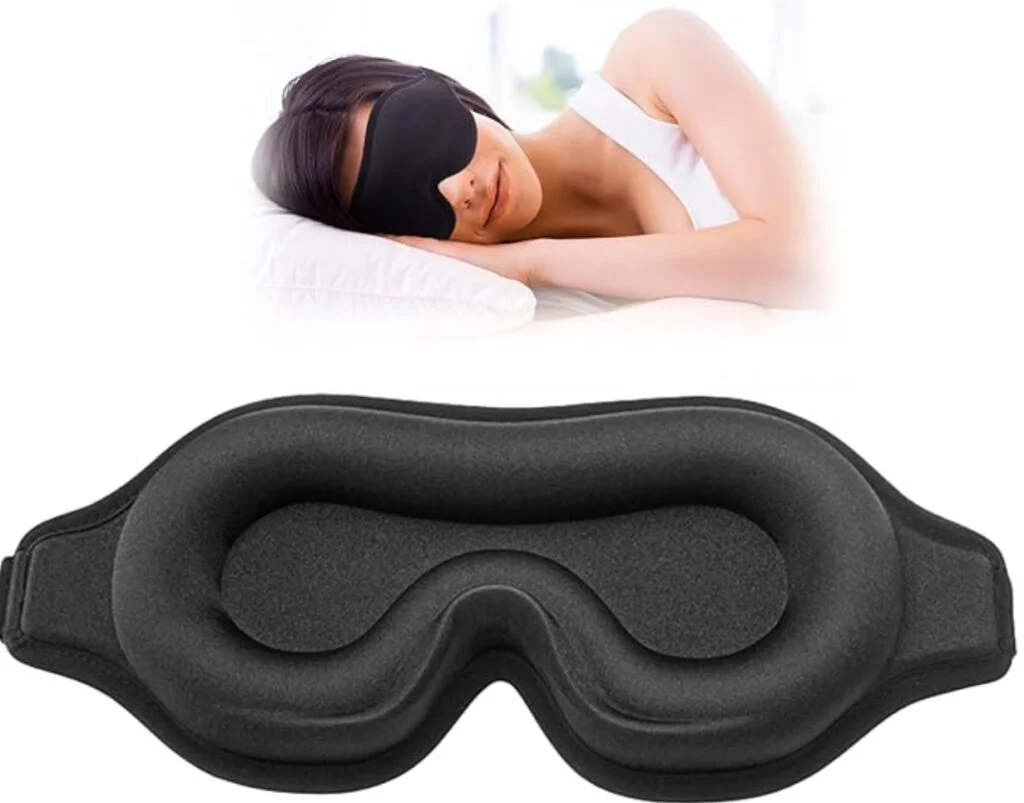
However, if you’d like more light, you might consider this motion-activated night light instead.
Fall Prevention Exercises
Fall prevention exercises are effective and easy to learn. Effective fall prevention exercises can be divided into:
- Balance: e.g., standing on one foot; shifting gaze while standing; perturbation exercises
- Strength: e.g., squats, shoulder bridges, and gluteus medius exercises
- Mobility: primarily for the foot, ankle, and hips
Balance exercises are important for fall prevention, but these should not be the only component of a fall prevention exercise program. You should include work on one foot, two feet, and shifting your balance.
It is important that the stabilizer muscles, such as the gluteal and abdominal muscles, have enough strength to counter the inertial force of a fall. Interestingly, in this study the ubiquitous clam-shell exercise has proven less effective in strengthening the gluteus medius than a simple hip hike.
In terms of mobility, mobility of the entire foot, ankles, and hips is certainly encouraged. But, since many falls happen when someone’s gaze is quickly shifted, full mobility of the neck and trunk is also very important.
Free Fall Prevention Handouts and PDFs
Free fall prevention handouts, PDFs, and brochures are a great way to keep your clients informed about how they can play a role in their own safety. It’s no exaggeration to say that fall prevention handouts can save lives!
A great thing about this fall prevention specialist course is that it includes a number of free handouts for fall prevention. These include:
- Questionnaires to determine if you’re at risk for falling
- Illustrated exercises to reduce the risk of fall
- Safety checklists to inspect your home for fall hazards
- Medicines whose interactions can make you more prone to fall
Some fall prevention handouts and tips can also be found on national fall prevention websites here and here.
Conclusion
The Fall Prevention Specialist Certification is an excellent online course that is full of practical information and exercises. Medical professionals will appreciate the opportunity to earn CECs while learning from an expert with significant clinical and research experience. The course is also incredibly valuable for anyone working with folks who are at risk for falling or who simply want to improve their balance and mobility.
Our fall prevention course review finds that PESI’s Fall Prevention Specialist Certification is an excellent value for the amount of information and resources that are contained here. It is a very worthwhile investment, and this fall prevention course can have immediate benefits for your clients.
Our link gives you an exclusive discount on the course. Click here for more information about the Fall Prevention Specialist Certification.
Frequently Asked Questions
How many CEC hours are available with the Fall Prevention Specialist course?
You can earn up to 12.5 CE hours.
What are some other certifications offered through PESI?
PESI offers a number of certifications you can earn for general interest or continuing education credit. Here are some top recommendations:
Sources
Montero-Odasso, Manuel, et al. “World guidelines for falls prevention and management for older adults: a global initiative.” Age and ageing 51.9 (2022): afac205. link
Moore, Damien et al. “A Systematic Review and Meta-Analysis of Common Therapeutic Exercises that Generate Highest Muscle Activity in the Gluteus Medius and Gluteus Minimus Segments.” International journal of sports physical therapy vol. 15,6 (2020): 856-881. doi:10.26603/ijspt20200856 link
Panel on Prevention of Falls in Older Persons, American Geriatrics Society and British Geriatrics Society. “Summary of the updated American Geriatrics Society/British Geriatrics Society clinical practice guideline for prevention of falls in older persons.” Journal of the American Geriatrics Society 59.1 (2011): 148-157.
Sherrington C, Michaleff ZA, Fairhall N, Paul SS, Tiedemann A, Whitney J, Cumming RG, Herbert RD, Close JCT, Lord SR. Exercise to prevent falls in older adults: an updated systematic review and meta-analysis. Br J Sports Med. 2017 Dec;51(24):1750-1758. doi: 10.1136/bjsports-2016-096547. Epub 2016 Oct 4. PMID: 27707740. link
Vieira, Edgar R., Richard C. Palmer, and Paulo HM Chaves. “Prevention of falls in older people living in the community.” Bmj 353 (2016).
https://www.sralab.org/rehabilitation-measures
https://www.physio-pedia.com/Fear_of_Falling
https://www.nia.nih.gov/health/falls-and-falls-prevention/preventing-falls-home-room-room

